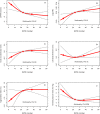Physical activity measured by accelerometry and its associations with cardiac structure and vascular function in young and middle-aged adults
- PMID: 25792127
- PMCID: PMC4392434
- DOI: 10.1161/JAHA.114.001528
Physical activity measured by accelerometry and its associations with cardiac structure and vascular function in young and middle-aged adults
Abstract
Background: Physical activity is associated with several health benefits, including lower cardiovascular disease risk. The independent influence of physical activity on cardiac and vascular function in the community, however, has been sparsely investigated.
Measures and results: We related objective measures of moderate- to vigorous-intensity physical activity (MVPA, assessed by accelerometry) to cardiac and vascular indices in 2376 participants of the Framingham Heart Study third generation cohort (54% women, mean age 47 years). Using multivariable regression models, we related MVPA to the following echocardiographic and vascular measures: left ventricular mass, left atrial and aortic root sizes, carotid-femoral pulse wave velocity, augmentation index, and forward pressure wave. Men and women engaged in MVPA 29.9±21.4 and 25.5±19.4 min/day, respectively. Higher values of MVPA (per 10-minute increment) were associated with lower carotid-femoral pulse wave velocity (estimate -0.53 ms/m; P=0.006) and lower forward pressure wave (estimate -0.23 mm Hg; P=0.03) but were not associated with augmentation index (estimate 0.13%; P=0.25). MVPA was associated positively with log(e) left ventricular mass (estimate 0.006 log(e) [g/m(2)]; P=0.0003), left ventricular wall thickness (estimate 0.07 mm; P=0.0001), and left atrial dimension (estimate 0.10 mm; P=0.01). MVPA also tended to be positively associated with aortic root dimension (estimate 0.05 mm; P=0.052). Associations of MVPA with cardiovascular measures were similar, in general, for bouts lasting <10 versus ≥10 minutes.
Conclusions: In our community-based sample, greater physical activity was associated with lower vascular stiffness but with higher echocardiographic left ventricular mass and left atrial size. These findings suggest complex relations of usual levels of physical activity and cardiovascular remodeling.
Keywords: echocardiography; epidemiology; physical activity; vascular measures.
© 2015 The Authors. Published on behalf of the American Heart Association, Inc., by Wiley Blackwell.
Figures

Similar articles
-
The relation of red blood cell fatty acids with vascular stiffness, cardiac structure and left ventricular function: the Framingham Heart Study.Vasc Med. 2015 Feb;20(1):5-13. doi: 10.1177/1358863X14560808. Epub 2014 Dec 17. Vasc Med. 2015. PMID: 25520318
-
Longitudinal Changes in LV Structure and Diastolic Function in Relation to Arterial Properties in General Population.JACC Cardiovasc Imaging. 2017 Nov;10(11):1307-1316. doi: 10.1016/j.jcmg.2016.10.018. Epub 2017 Mar 15. JACC Cardiovasc Imaging. 2017. PMID: 28330663
-
The Relationship of Carotid Arterial Stiffness and Left Ventricular Concentric Hypertrophy in Hypertension.Adv Clin Exp Med. 2016 Mar-Apr;25(2):263-72. doi: 10.17219/acem/34654. Adv Clin Exp Med. 2016. PMID: 27627559
-
Predictors and Consequences of Pediatric Hypertension: Have Advanced Echocardiography and Vascular Testing Arrived?Curr Hypertens Rep. 2019 May 27;21(7):54. doi: 10.1007/s11906-019-0958-3. Curr Hypertens Rep. 2019. PMID: 31134437 Review.
-
The 24-h activity cycle and cardiovascular outcomes: establishing biological plausibility using arterial stiffness as an intermediate outcome.Am J Physiol Heart Circ Physiol. 2023 Dec 1;325(6):H1243-H1263. doi: 10.1152/ajpheart.00258.2023. Epub 2023 Sep 22. Am J Physiol Heart Circ Physiol. 2023. PMID: 37737729 Free PMC article. Review.
Cited by
-
Physical Activity and Characteristics of the Carotid Artery Wall in High-Risk Patients-The SMART (Second Manifestations of Arterial Disease) Study.J Am Heart Assoc. 2017 Jul 23;6(7):e005143. doi: 10.1161/JAHA.116.005143. J Am Heart Assoc. 2017. PMID: 28736388 Free PMC article.
-
Data Analytics in Physical Activity Studies With Accelerometers: Scoping Review.J Med Internet Res. 2024 Sep 11;26:e59497. doi: 10.2196/59497. J Med Internet Res. 2024. PMID: 39259962 Free PMC article.
-
Carotid femoral pulse wave velocity in type 2 diabetes and hypertension: capturing arterial health effects of step counts.J Hypertens. 2017 May;35(5):1061-1069. doi: 10.1097/HJH.0000000000001277. J Hypertens. 2017. PMID: 28129250 Free PMC article.
-
Associations between physical activity, sedentary behaviour and left ventricular structure and function from the Echocardiographic Study of Latinos (ECHO-SOL).Open Heart. 2021 Jul;8(2):e001647. doi: 10.1136/openhrt-2021-001647. Open Heart. 2021. PMID: 34261776 Free PMC article.
-
Association Between Physical Activity Timing and Metabolic Syndrome in Korea: A Functional Principal Component Approach.Healthcare (Basel). 2025 Jun 10;13(12):1384. doi: 10.3390/healthcare13121384. Healthcare (Basel). 2025. PMID: 40565411 Free PMC article.
References
-
- Haskell WL, Lee IM, Pate RR, Powell KE, Blair SN, Franklin BA, Macera CA, Heath GW, Thompson PD, Bauman A. Physical activity and public health: updated recommendation for adults from the american college of sports medicine and the american heart association. Circulation. 2007; 116:1081-1093. - PubMed
-
- Manson JE, Greenland P, LaCroix AZ, Stefanick ML, Mouton CP, Oberman A, Perri MG, Sheps DS, Pettinger MB, Siscovick DS. Walking compared with vigorous exercise for the prevention of cardiovascular events in women. N Engl J Med. 2002; 347:716-725. - PubMed
-
- Morris JN, Everitt MG, Pollard R, Chave SP, Semmence AM. Vigorous exercise in leisure‐time: protection against coronary heart disease. Lancet. 1980; 2:1207-1210. - PubMed
-
- Sesso HD, Paffenbarger RS, Jr, Lee IM. Physical activity and coronary heart disease in men: the harvard alumni health study. Circulation. 2000; 102:975-980. - PubMed
Publication types
MeSH terms
Grants and funding
LinkOut - more resources
Full Text Sources

